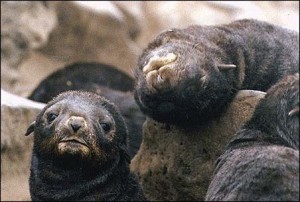14 December 2010
Northern fur seals may need to return to their roots if they’re going to survive
Posted by mohi
Most of today’s Northern fur seal population hails from a four-island rookery in the Bering Sea. But that wasn’t always the case. And as climate change, overfishing, and hungry killer whales hammer away at this dwindling population, they may do well to come back home to sunny California.
Northern fur seal moms used to birth their babes on the shores of central California and the Baja Peninsula. But those populations began to disappear more than 500 years ago–probably from hunting pressures imposed by Native Americans in the area. Once the southernmost populations crashed, the Pribilof Islands of the Bering Sea became the center of activity for breeding and birthing of Northern fur seals.
More than three-quarters of the entire world population of northern fur seals hail from the Pribilof Islands where the seals return every year to handle their reproductive business. Unfortunately, business is not booming. Pribilof population numbers are way down since their boom years prior to the 18th century, and scientists are not entirely sure why.
In his talk yesterday (B11H-06), “Isotopic and genetic insights into the persistence of the Northern fur seal (Callorhinus ursinus),” Paul Koch of UC Santa Cruz explained that the animals appear to have all the right stuff, genetically speaking, to make a full recovery. Some of the seals are even coming home to their historic breeding grounds in the Pacific Northwest and the California barrier islands. But their Bering Sea heritage may be betraying them.
Koch’s team examined isotopes and DNA gathered from archaeological studies of historic breeding grounds from the Aleutian Islands down to the southern Baja Peninsula and found that northern fur seals that once inhabited the temperate latitudes nursed their young for over a year before the pups struck out on their own. In the modern Bering Sea populations, however, the pups are weaned by their forth month of life–a “must do” adaptation so that the pups can begin foraging on their own before the sea around their nursery becomes covered with ice.
However, the adaptation doesn’t work so well in the temperate latitudes where an entire generation of young pups could potentially be wiped out by El Niño storms–strong El Niños not only make food too scarce for the novice hunters to survive, but they also occur in cycles difficult to predict. Pups in such volatile environments need more time with mom if they are going to make it through the first year of life.
Apparently, the seals have the genetic diversity required to adapt to optimal weaning schedules for temperate climates, but they aren’t making the change. Not yet, anyway. Koch says that most of the fur seals that have moved their habitats southward are coming from the northern rookery in the Bering Sea, where the four-month nursing limit is essential, and they pass the trait for early weaning on to their pups.
Nonetheless, Koch thinks that seals from the Pribilof Islands may be good candidates for relocation to historic southern breeding grounds if they need to be moved in the future to ensure their survival. We don’t know why Pribilof populations continue to decline, but relocation may be a viable conservation strategy in this situation. The seals have the genetic material to readapt their pup-rearing ways to suit temperate climates–it is entirely possible that they could evolve to once again nurse their pups for a year or more.
–Donna Hesterman is a science communication graduate student at UC Santa Cruz



 GeoSpace is a blog on Earth and space science, managed by AGU’s Public Information staff. The blog features posts by AGU writers and guest contributors on all sorts of relevant science topics, but with a focus on new research and geo and space sciences-related stories that are currently in the news.
GeoSpace is a blog on Earth and space science, managed by AGU’s Public Information staff. The blog features posts by AGU writers and guest contributors on all sorts of relevant science topics, but with a focus on new research and geo and space sciences-related stories that are currently in the news.